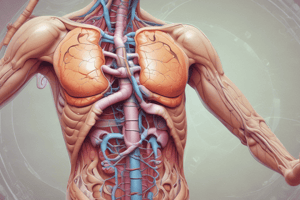Podcast
Questions and Answers
What is one primary role of the gastrointestinal tract?
What is one primary role of the gastrointestinal tract?
- To provide a barrier against all pathogens
- To transport and break down food products (correct)
- To directly absorb all nutrients without any processing
- To detoxify all harmful substances
Which of the following structures is primarily responsible for regulating gut motility?
Which of the following structures is primarily responsible for regulating gut motility?
- Ovaries and adrenal glands
- Enteric nervous system, smooth muscle cells, and interstitial cells of Cajal (correct)
- Gastric acids and bile salts
- Salivary glands and pancreas
What role does the gut microbiome play in human physiology?
What role does the gut microbiome play in human physiology?
- It complicates digestive processes and causes irritation
- It has no impact on health
- It aids in digestion and maintains intestinal health (correct)
- It solely helps in food absorption
How does gut dysbiosis potentially affect health?
How does gut dysbiosis potentially affect health?
Which factor is known to influence the gut microbiome significantly?
Which factor is known to influence the gut microbiome significantly?
What happens if food is transported too quickly through the gastrointestinal tract?
What happens if food is transported too quickly through the gastrointestinal tract?
Which hormone is released in response to the presence of peptides or free fatty acids that promotes gastrointestinal motility?
Which hormone is released in response to the presence of peptides or free fatty acids that promotes gastrointestinal motility?
What is a potential consequence of food staying in the stomach for too long?
What is a potential consequence of food staying in the stomach for too long?
Which type of cells respond to mechanical stimulation (such as distention) to influence gastrointestinal motility?
Which type of cells respond to mechanical stimulation (such as distention) to influence gastrointestinal motility?
What effect does a slow transportation of food have on the gastrointestinal tract?
What effect does a slow transportation of food have on the gastrointestinal tract?
Study Notes
Gastrointestinal Tract Overview
- GI tract transports 60 tonnes of food throughout an individual's lifetime.
- Functions include digestion, absorption, and decontamination of food by-products.
- Interfaces with non-human cells (bacteria, viruses, fungi) and the immune system.
Gut Physiology
- Motility: Influenced by smooth muscle cells, interstitial cells of Cajal (ICC), and enteric nervous system (ENS). Timing is crucial for digestion and absorption.
- Digestion: Requires a balance; rapid transport may lead to insufficient digestion, whereas delayed movement may cause irritation.
- Absorption: Primarily occurs in the small intestine, relying on structural integrity and timing for effective nutrient uptake.
Absorption Processes
-
Carbohydrate Absorption:
- Glucose and galactose transported via Na+/glucose co-transporter (SGLT1).
- Fructose absorbed via GLUT-5.
- Monosaccharides enter the bloodstream via GLUT-2.
-
Protein Absorption:
- Majority absorbed in the duodenum; only 2-3% escapes digestion.
- Na+ symporters and PepT1 transport dipeptides/tripeptides into enterocytes for hydrolysis.
-
Nucleic Acid Absorption:
- Nucleic acids broken into nucleotides, further into nucleosides for absorption via active transport.
-
Fat Absorption:
- Long-chain fatty acids processed into chylomicrons after re-esterification and transported via lymphatics.
Gut Microbiome
- Comprises an estimated 100 trillion cells, including bacteria, viruses, and fungi.
- Composition influences intestinal health, with Bacteroides and Lactobacillus playing significant roles.
- Microbiome relates bidirectionally to human health, influencing digestion and motility.
Gut Dysbiosis and Health Impacts
- Dysbiosis can influence inflammatory responses and increase permeability of the gut.
- Involvement of different bacterial species in maintaining epithelial cell integrity; disruptions can lead to conditions like Clostridium difficile overgrowth.
Gut Motility Influences
- Probiotics may improve motility in constipated patients.
- Short-chain fatty acids (SCFAs) boost serotonin production, promoting motility.
- Methane from certain bacteria may slow motility.
Antibiotic Effects on Microbiome
- Bacteriostatic: Inhibits bacterial activity without killing bacteria. Requires immune system intervention.
- Bactericidal: Directly kills bacteria; may increase adverse events.
- Antibiotics can reduce species diversity, alter metabolic activities, and lead to antibiotic-associated diarrhea (AAD).
Antibiotic-associated Diarrhea (AAD)
- Occurs in 5-30% of individuals during or up to 2 months post-antibiotic treatment.
- Increased risk factors include age, immunosuppression, and prolonged hospitalization.
- Recovery of gut bacteria to baseline state can take weeks, but long-term dysbiosis is also a concern.
Studying That Suits You
Use AI to generate personalized quizzes and flashcards to suit your learning preferences.
Related Documents
Description
This quiz covers the physiology of the gastrointestinal tract, including aspects of motility, digestion, absorption, and regulation. Additionally, it introduces the gut microbiome, its typical families, and its significant roles in human health. Prepare to explore the bidirectional relationship between gut microbiome and physiology.




